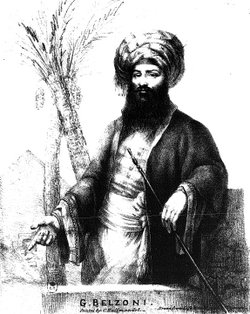![[famous, archaeologist, archaeology]](../local/enlightenment.gif)
career, famous, archaeologist, Giovanni Belzoni, Belzoni, archaeologist, archaeology
archaeology, famous archaeologists, famous archaeologist![[famous, archaeologist, archaeology]](../local/enlightenment.gif) career, famous, archaeologist, Giovanni Belzoni, Belzoni, archaeologist, archaeology |
| Home > Some famous archaeologists & Archaeology index > Giovanni Belzoni |
|
|||
Giovanni Belzoni archaeologist Giovanni Battista Belzoni was an
engineer and an explorer of Egyptian antiquities. He was born in Padua, Italy on
November 15, 1778. Giovanni was a son of a barber and was one of fourteen siblings. Whilst still a young child
Belzoni showed some interest and talent in engineering that was encouraged in this interest by his family. At
the age of 16, Belzoni joined a monastic order in Rome after a disappointment in love. In this role he had some opportunity
to exercise his skills in mechanics and hydraulics. However, while he was in the monastic order there were also ongoing turmoils
associated with a revolution in France that had begun to spread more widely in Europe led to Belzoni becoming
entangled in political matters as the French authorities dissolved the monastic order and eventually
fled to the Netherlands (1800) and England (1803) to avoid
being sent to jail. In England, Belzoni in despair at not find any employment in engineering and mechanics and having taken
on a young wife, joined a traveling circus and was billed as
“Patagonian Samson.” He was in fact some two metres (6'7") tall and possessed of immense strength.
This career lasted twelve years and included several years spent with the famous
Astley's Circus due to the patronage of Henry Salt, the traveller and antiquarian. Giovanni Battista Belzoni was an
engineer and an explorer of Egyptian antiquities. He was born in Padua, Italy on
November 15, 1778. Giovanni was a son of a barber and was one of fourteen siblings. Whilst still a young child
Belzoni showed some interest and talent in engineering that was encouraged in this interest by his family. At
the age of 16, Belzoni joined a monastic order in Rome after a disappointment in love. In this role he had some opportunity
to exercise his skills in mechanics and hydraulics. However, while he was in the monastic order there were also ongoing turmoils
associated with a revolution in France that had begun to spread more widely in Europe led to Belzoni becoming
entangled in political matters as the French authorities dissolved the monastic order and eventually
fled to the Netherlands (1800) and England (1803) to avoid
being sent to jail. In England, Belzoni in despair at not find any employment in engineering and mechanics and having taken
on a young wife, joined a traveling circus and was billed as
“Patagonian Samson.” He was in fact some two metres (6'7") tall and possessed of immense strength.
This career lasted twelve years and included several years spent with the famous
Astley's Circus due to the patronage of Henry Salt, the traveller and antiquarian. After leaving the circus, Belzoni, his wife Sarah, and their Irish servant James Curtin traveled to Portugal and to Spain in accordance with contracts of employment as a circus strongman. From there Belzoni continued to Egypt. While in Cairo he offered his invention of a hydraulic machine to Mehmet Ali Pasha. Though this invention did seem to increase the availability of water Belzoni's invention was not taken up by Mehmet Ali Pasha. Belzoni became fascinated by Cairo and Egypt, he adopted local dress and grew a substantial beard.
For the next few years, Belzoni would do things that few or no one had done. He was charged with the difficult task of moving the two seated statues of Ramses II from Luxor to the British Museum. In 1817, he traveled to the Valley of Kings and discovered the tombs of Amenhotep III, Ramses I, Merneptah and Ay. While investigating these tombs he spotted indications of another royal tomb near the tomb of Ramses I. Eighteen feet below the surface of the ground, Belzoni discovered the entrance to the sepulchre of Seti I, Ramses I's son. This tomb has frequently been referred to as "Belzoni's tomb" in tribute to this discovery In the following year of 1818, Belzoni was the first person in modern times to enter the innermost chambers of the pyramid of Khafre at Giza. The entrance area had been deliberately confused by its designers with false passages and chambers. Belzoni used “his engineering genius to locate the entrance to the inner chambers...” Belzoni was also the first European to visit the oasis of Siwah and to identify the ruined city of Berenice on the Red Sea. In 1819, Belzoni returned to England. A year later in 1820, he published a book that made him quite famous. It was entitled Narrative of the Operations and Recent Discoveries Within the Pyramids, Temples, Tombs, and Excavations in Egypt and Nubia. this work is credited as being the first English research in Egyptology. Three editions of the book were published and it was received with great interest. On May 1, 1921, Belzoni got an opportunity to share his finds. A great exhibition called Egyptian Hall was set up in Piccadilly near Piccadilly Circus. This room reflected Belzoni’s expeditions and contained plaster casts from the tomb of Seti I. While on an excavation to Timbuktu in north western Africa , Belzoni caught dysentery and died on December 3, 1823 at Gato in Benin. He was buried under an Arasma tree in Gwata, a nearby village. Belzoni was no intellectual scholar, he was an amateur archaeologist. As an explorer he was motivated by finding hidden treasure so that he could sell the artifacts to collectors. His methods were often destructive and quite unorthodox but his discoveries laid the foundation for the scientific study of Egyptology. From this point of view, Howard Carter summed up Belzoni as "one of the most remarkable men in the entire history of Archaeology." |
|
||||||||||||||||||||||||
Space Archaeology
| ||||||
Return to start of
Giovanni Belzoni archaeologist & archaeology page